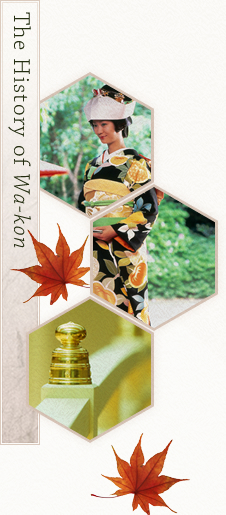“ Wa-kon ”, or the Japanese wedding, has a long history, as suggested by its appearance in the ancient “ Kojiki ” and “ Nihon Shoki ” chronicles. A number of records on the subject survive from the Heian and Edo eras to the present day.
In Heian times, there was the custom of “ kayoi-kon ”, in which the man would first visit the woman’s house to court her. On the third day of this courtship, the wedding banquet would be held, giving rise to the modern-day hirōen reception. In courtly circles, the bride would wear costumes like the jūnihitoe (literally “twelve-layer robe”), and multi-colored garments were vogue. Among the ordinary people, however, white was preferred as a color for kimono garments with long trailing sleeves and hems. These were similar to the kurohikisode , the full-length, embroidered black kimono of today.
In the Muromachi era, a white uchikake (full-length outer robe) came to be worn over a long-hemmed kimono as a ceremonial costume in respectable samurai families. This is the origin of today’s shiromuku (bridal white kimono ).
In Edo days, the preferred style of ceremony amongst ordinary people was what would today be called “ jinzen-shiki ” (non-religious ceremony). Relatives and neighbors would be invited to the bridal home, and the wedding vows would be exchanged in front of them. The term “ shūgen ” (marriage ceremony, literally “words of felicitation”) is said to have originated from the congratulatory messages spoken on such occasions.
In this “ jinzen-shiki ” style, the bride and groom would exchange saké cups in front of a low table, a scene often seen in Edo period dramas. After the ceremony, a reception would be held in the same house. The head of the house would provide food, while relatives and friends would perform dances and other entertainment.
In those days, embroidered uchikake and other gaudy costumes came to be worn, not only as formal wear, while splendid uchikake emblazoned with samurai family crests were used as bridal gear. The custom of ironaoshi , when the bride changes costume for the wedding party, started at this time.
It was after the Meiji Restoration in 1867 that the shinzen (Shinto) style of ceremony often seen today came into being. This resulted from a growing awareness of “Japanese-ness” amid the wave of westernization.
This trend was sparked, in particular, by the wedding of the future Emperor Taishō in 1900. In the following year, the present Tokyo Daijingū Shrine was established on the model of imperial wedding ceremonies, and the shinzen-shiki wedding then spread in popularity among the ordinary people.












